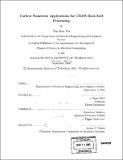| dc.contributor.advisor | L. Rafael Reif. | en_US |
| dc.contributor.author | Wu, Tan Mau, 1979- | en_US |
| dc.contributor.other | Massachusetts Institute of Technology. Dept. of Electrical Engineering and Computer Science. | en_US |
| dc.date.accessioned | 2006-03-24T18:26:58Z | |
| dc.date.available | 2006-03-24T18:26:58Z | |
| dc.date.copyright | 2004 | en_US |
| dc.date.issued | 2005 | en_US |
| dc.identifier.uri | http://hdl.handle.net/1721.1/30179 | |
| dc.description | Thesis (S.M.)--Massachusetts Institute of Technology, Dept. of Electrical Engineering and Computer Science, February 2005. | en_US |
| dc.description | Includes bibliographical references (p. 73-75). | en_US |
| dc.description.abstract | Carbon nanotubes are a recently discovered material with excellent mechanical, thermal, and electronic properties. In particular, they are potential ballistic transporters and are theorized to have thermal conductivities greater than any other material currently known. In this thesis, we will examine two possible applications of carbon nanotubes in CMOS back-end processing. The first application is as a replacement for copper interconnects. As interconnect line widths shrink, the electrical resistivity of copper will rise dramatically due to surface scattering effects. Carbon nanotube ballistic transporters may be able to overcome this obstacle, as well as being able to withstand current densities much greater than copper. The second application is an enhanced thermal conductivity dielectric for thermal management purposes. Carbon nanotube-oxide composites demonstrate improved thermal characteristics, and integration into CMOS technology may be able to alleviate some of the heat-removal and distribution problems future integrated circuits will face. We will also examine some of the processing techniques that will be necessary for carbon nanotube commercial deployment. Some of the issues we will discuss are nanotube growth, purification, and separation. In addition, we will consider some of the specific issues that need to be addressed for carbon nanotube integration into CMOS back-end technology, such as in situ growth and self-assembly. | en_US |
| dc.description.statementofresponsibility | by Tan Mau Wu. | en_US |
| dc.format.extent | 75 p. | en_US |
| dc.format.extent | 3719310 bytes | |
| dc.format.extent | 3727171 bytes | |
| dc.format.mimetype | application/pdf | |
| dc.format.mimetype | application/pdf | |
| dc.language.iso | eng | en_US |
| dc.publisher | Massachusetts Institute of Technology | en_US |
| dc.rights | M.I.T. theses are protected by copyright. They may be viewed from this source for any purpose, but reproduction or distribution in any format is prohibited without written permission. See provided URL for inquiries about permission. | en_US |
| dc.rights.uri | http://dspace.mit.edu/handle/1721.1/7582 | |
| dc.subject | Electrical Engineering and Computer Science. | en_US |
| dc.title | Carbon nanotube applications for CMOS back-end processing | en_US |
| dc.type | Thesis | en_US |
| dc.description.degree | S.M. | en_US |
| dc.contributor.department | Massachusetts Institute of Technology. Department of Electrical Engineering and Computer Science | |
| dc.identifier.oclc | 60679348 | en_US |
